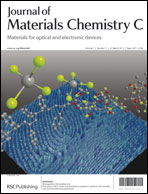Biomimetic zinc chlorin–poly(4-vinylpyridine) assemblies: doping level dependent emission–absorption regimes†
Abstract
To develop biomimetic dye–

- This article is part of the themed collection: 2013 Journal of Materials Chemistry C Hot Papers

 Please wait while we load your content...
Please wait while we load your content...